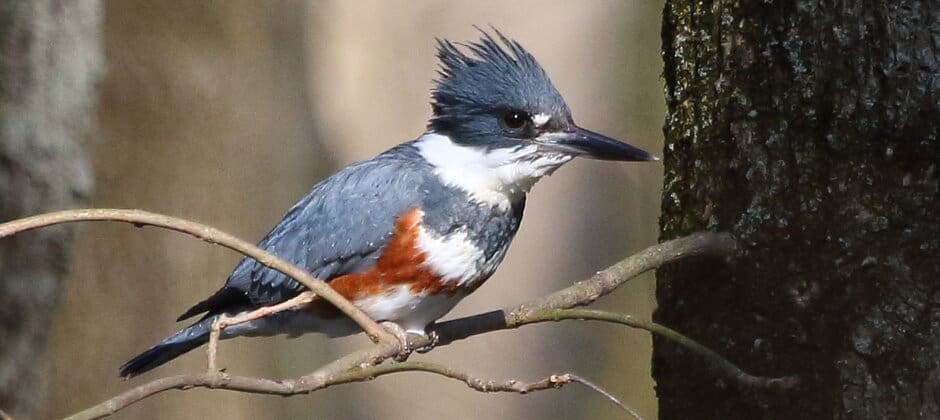Share this article
Here’s what’s happening in the North Central Section: Part 1
Below is a summary of recent chapter activities within the North Central Section of The Wildlife Society, which was included in the section’s Spring 2021 newsletter. The newsletter includes updates from the Iowa, Missouri, Ohio and Wisconsin Chapters of The Wildlife Society. Photos highlighting chapter activities are also included in the section’s Spring 2021 newsletter.
State Chapter Reports:
Iowa Chapter of The Wildlife Society
The Iowa Chapter elected to forego their traditional two-day, in-person winter meeting due to COVID-19 concerns, and instead hosted a one-day virtual meeting via Zoom this past February. The 120 attendees viewed and interacted in eight presentations on a range of topics including duck use of agricultural wetlands, Canada goose movement, pheasant use of cover crops, breeding bird response to honeysuckle removal, enhancing mussel habitat on private lands, climate-ready pollinator habitat, and wildlife management in agricultural landscapes. In addition, a keynote speaker talked about the connection between wildlife and human disease in light of COVID-19.
Missouri Chapter of The Wildlife Society
The Missouri Chapter shared the below Missouri Department of Conservation article regarding an exciting project:
The Missouri Department of Conservation (MDC) and Missouri State Western University (MSWU) recently dedicated a native grassland restoration on the university campus. A ribbon-cutting marked the end of the first growing season for the John Rushin Teaching and Research Prairie. The grassland is named for John Rushin, a retired biology department director at the university. Native grasses and wildflowers represent the natural ecology that once covered most of northwest Missouri’s rolling hills.
“I am honored beyond my wildest expectations in having my name on this project,” Rushin said. “Most of all, I am very happy that MDC and the biology department can move forward on a project like this in these difficult times.” The Missouri Department of Conservation helped plant 26 acres of prairie wildflowers and grasses early in 2020. The planting is part of a 38-acre tract that includes the MWSU athletic department’s cross-country running course. Students will use the planting to study prairie ecology, and the public will get to visit to enjoy the wildflowers.
“This is the beginning of a great outdoor learning space that will be used by students, faculty, and the community for years to come,” said Mark Mills, MWSU biology professor, who helped plan the restoration. “I want to thank our partners, especially Jeff Powelson and the Missouri Department of Conservation for all that they have done to make this prairie a reality.” The Nature Conservancy donated native plant seeds collected at Dunn Ranch Prairie in Harrison County. The Missouri Department of Conservation purchased a high diversity seed mix. The seeds planted include 80 different species of native grasses and wildflowers. Deep-rooted prairie plants take time to develop root systems and relationships with the soil microbes that have a symbiotic relationship with natives. The grassland will begin showing a fuller expression with tall grasses and blooming wildflowers in the third growing season, Powelson said. Walking trails, interpretive markers and a savannah tree planting are also part of the restoration plan.
Ohio Chapter of The Wildlife Society
The Ohio Chapter’s activity has slowed down due to COVID-19, but members still took part in a few beneficial events. In January, many members attended the virtual Ohio Wildlife Management Association conference, where presenters explored topics from Blanding’s turtle restoration to the effects of fire and grazing on pollinator habitat. At the year’s turn, the chapter also welcomed Catherine Dennison and Erin Hazelton to the board. Despite a relatively slow year, the horizon is bright with workshops and more being planned.
Wisconsin Chapter of The Wildlife Society
This year marked the Wisconsin Chapter’s 50th anniversary and the very first time the winter meeting was held virtually. More than 230 people registered for the event, which took place February 22 to 25. The meeting featured two special symposium sessions: “Winter-adapted species in a warming world” and “The state of private lands management in Wisconsin: Past, present, and future.” The conference plenary session focused on building a diverse and inclusive future for the profession and those engaged in natural resources. Student presenters dominated many of the general session talks. Students comprised 22 of the 31 conference talks, which were prerecorded before the meeting. The discussion has just begun for next year’s meeting! The chapter’s ongoing webinar series continues to be popular, and recent talks have covered citizen science, administering surveys and wild rice management. For those interested in attending future talks, upcoming webinars will be posted here.
Header Image: A Belted Kingfisher in Busey Woods, Urbana, IL. Credit: Jeff Bryant








